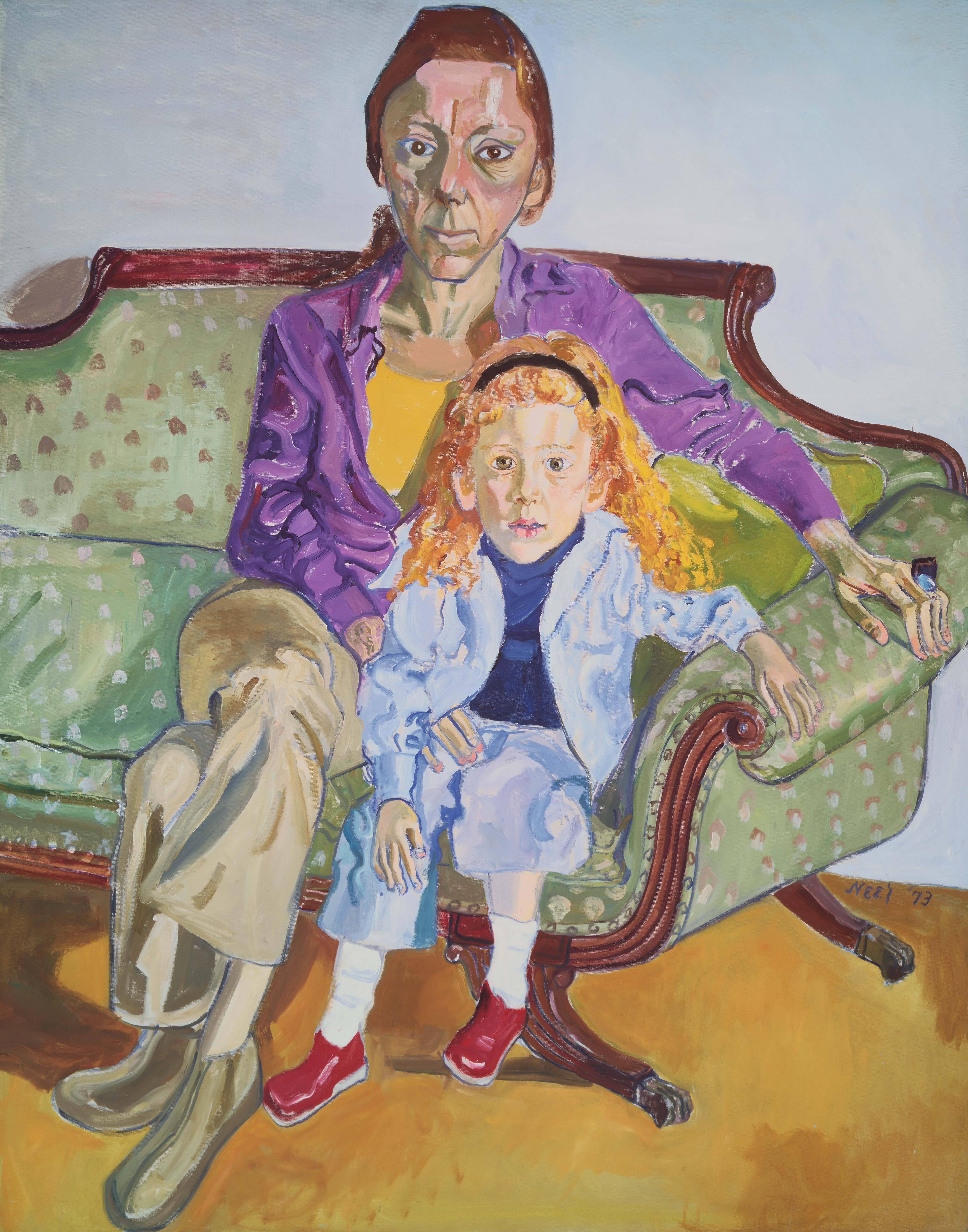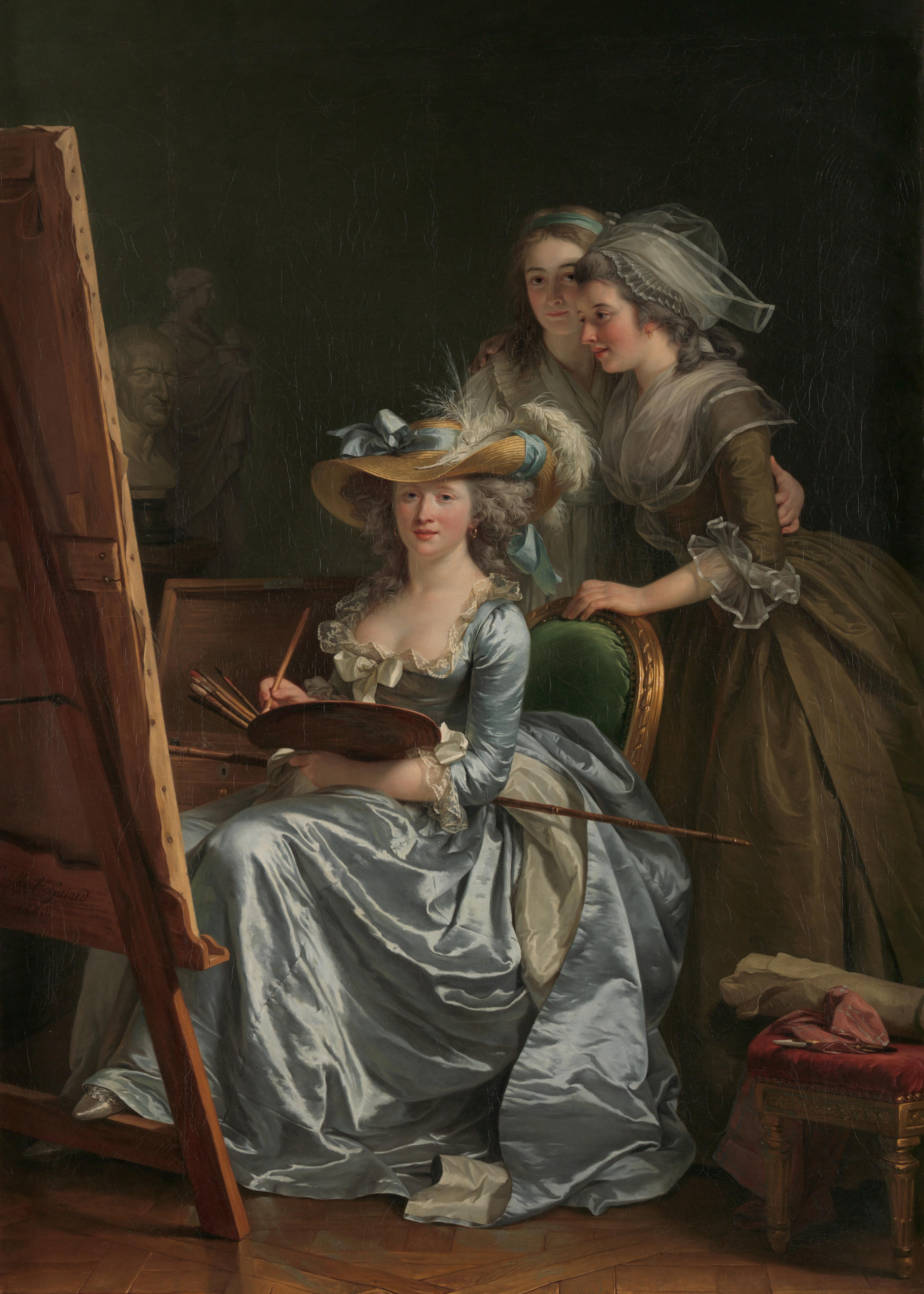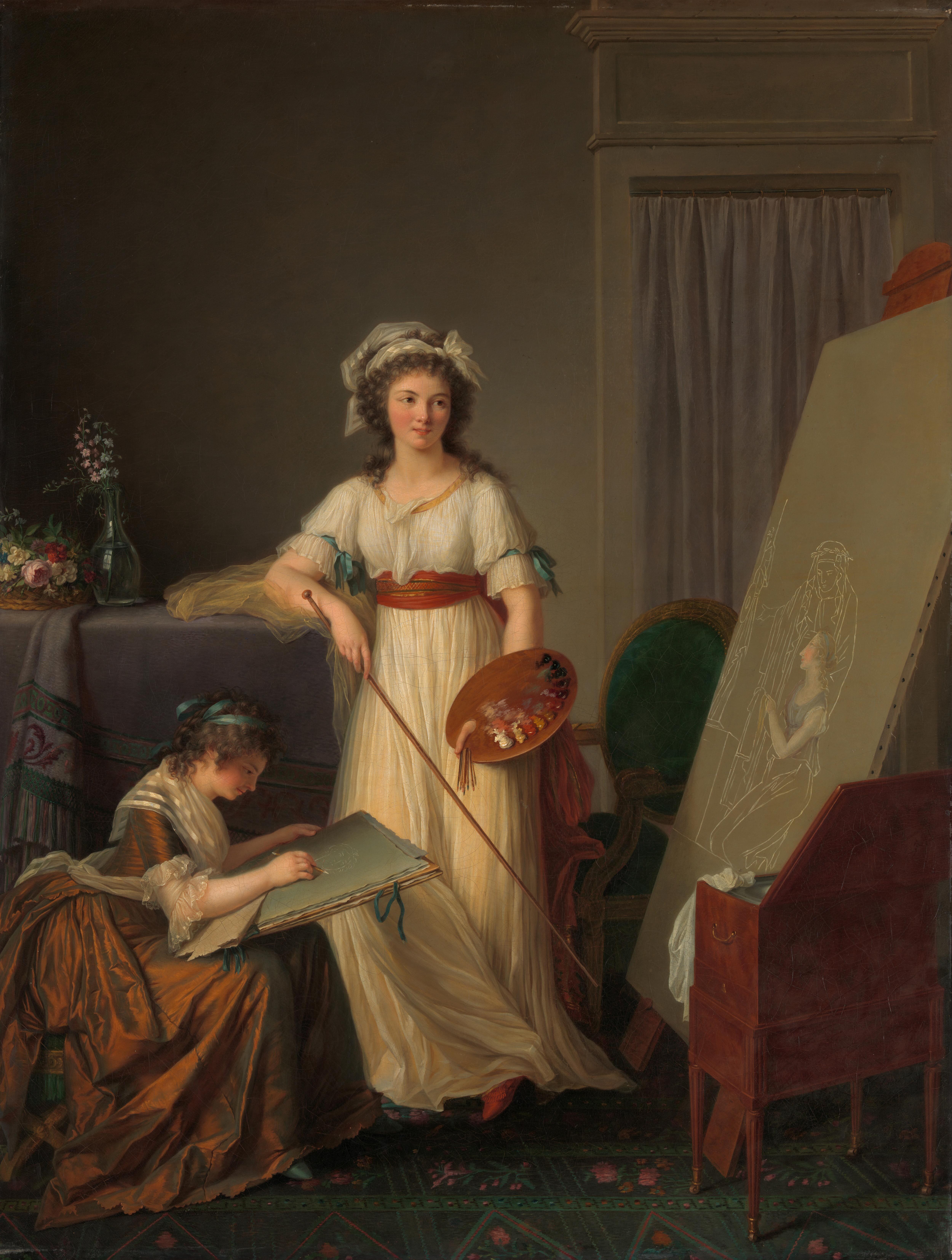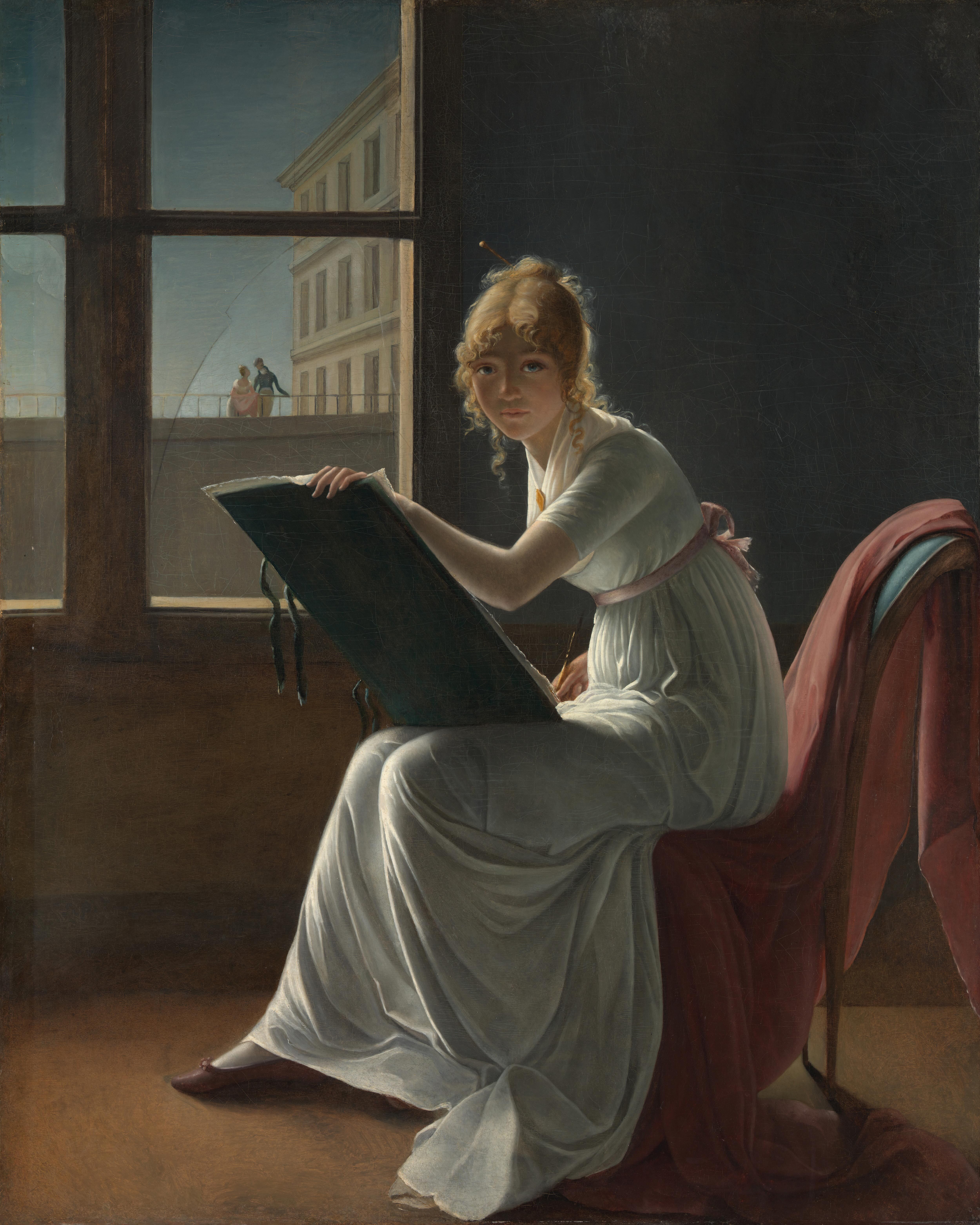As a graduate student in the 1990s, I studied art history with Linda Nochlin, depicted in this portrait by Alice Neel. It had been more than 20 years since Nochlin published her pioneering feminist essay, “Why Have There Been No Great Women Artists?”
Her text, which underscores the institutional and social barriers that generations of women artists faced in Europe and America, inspired a new generation of art historians and artists.
She taught us to question assumptions and to challenge accepted art-historical narratives.
One such narrative that is still unfolding is the role of women artists in the development of French painting at the end of the 18th century …
This magisterial work is a self-portrait of the 35-year-old artist Adélaïde Labille-Guiard (1749–1803) alongside two of her pupils.
In 1783 Labille-Guiard gained admittance to the Royal Academy of Painting and Sculpture. By decree of the French king, the elite institution allowed only four women members at any given moment.
Why were there so few women artists?
Convention dictated that a woman’s artistic pursuits should be limited to drawing as a private pastime. Figure painting was deemed the purview of men.
This self-portrait was shown in 1785 at the Paris Salon, a prestigious biennial exhibition where artists’ reputations were made—or ruined.
It audaciously signaled the artist’s ambition at a time when the notion of a professional woman artist went against society’s gender roles.
Labille-Guiard shows herself in her studio, at work on a large canvas.
The artist pauses, paintbrush poised over her palette, and gazes outward.
On her lap she balances a mahlstick, used to steady a painter’s working hand.
She announces her authorship with a prominent signature on the easel’s shelf.
At the same time, she forms an intimate trio with two of her students—Marie Marguerite Carreaux de Rosemond (left) and Marie-Gabrielle Capet (right)—asserting her role as a teacher of aspiring women artists.
The work is virtually unprecedented in the history of European painting. Before Labille-Guiard, few women in France had been admitted into the privileged ranks of the Academy, and she was one of only a small number to oversee a teaching studio in the 18th century.
Aspiring women artists encountered significant obstacles to professional success. They were barred from the Academy’s celebrated life-drawing class. In 1787, a royal decree effectively banned women and girls from artists’ studios in the Louvre.
In her painting, Labille-Guiard seemingly offered a response to those who questioned the propriety of a professional woman artist.
Notice this bust in the background. Carved in a classicizing style, it depicts Labille-Guiard’s father, a merchant. Made by French Neoclassical sculptor Augustin Pajou (1730–1809), it was also on view at the same Salon.
Next to it stands a figure of a vestal virgin—an ancient Roman maiden who vowed to remain chaste—by Jean-Antoine Houdon (1741–1828).
These sculptures underscore her devotion to her father and her feminine modesty, preemptively silencing any who might question her virtue.
Labille-Guiard painted in the Neoclassical style, as popularized by Jacques-Louis David (1748–1825) and his male students in the late 18th century.
Hallmarks of the style include a smooth, polished finish and clearly defined contours, as seen in David’s 1788 portrait of the Lavoisiers.

Labille-Guiard showcases her command of this style in her masterful rendering of a range of materials.
Notice the plumage of her straw hat, captured in delicate, feathery brushstrokes …
the shimmering silk folds of her fashionable robe à l’anglaise …
and the reflective sheen of the parquet wood floor.
The Neoclassical style was associated with masculinity, and critics responded in kind. They praised Labille-Guiard’s portrait for the “vigor” and “force” of its handling.
At least one reviewer assumed it was painted by a man.
The canvas measures some 7 by 5 feet; its figures are life sized. Its ambitious scale and Labille-Guiard’s use of oil paint represent a departure from her earlier portraits—mostly miniatures or pastels.
With this work, Labille-Guiard publicly claimed mastery of the Neoclassical style at the Salon. Her unambiguously feminine self-portrait is a powerful assertion of women’s rising status in the arts on the eve of the French Revolution of 1789.
A second portrait embodies the same current of revolutionary change.
This canvas, painted in 1789 by Marie Victoire Lemoine (1754–1820), also depicts a woman artist at work—likely Lemoine herself.
Her studio is set within a domestic interior. Palette and mahlstick in hand, she stands before an unfinished canvas.
It depicts a young woman kneeling before a statue of Athena, the Greek goddess of wisdom and the arts. She’s accompanied by a veiled woman, who might be a priestess or a vestal virgin.
Historical subjects such as this were the visual currency of Neoclassical painters, who looked to ancient Greece and Rome for inspiration.
Seated beside the artist on a tabouret, or low stool, a young woman—possibly her pupil—sketches what appears to be a portrait of Lemoine.
On the cloth-covered table, flowers are arranged in a basket and a glass vase that reflects the room’s unseen window.
The work boldly fuses different types of painting, as codified by the Academy in its hierarchy of genres:
History painting—scenes from the Bible, mythology, and ancient history—was considered the highest form of painting and the privileged domain of male artists. Portraiture was believed to require less artistic invention, and it ranked second.
Still life, thought best suited for women, was at the bottom of this hierarchy.
With this painting, Lemoine portrayed an artist in full command of her craft, capable of deploying multiple genres within a single composition.
Lemoine put forward this vision of women’s equality on the eve of the Revolution. The next 10 years witnessed the overthrow of the monarchy and the abolition of many of its institutions, including the Royal Academy of Painting and Sculpture.
In 1791, the Salon opened its doors to “all French or foreign artists,” and in the ensuing decades the number of women who exhibited artworks steadily increased.
Between 1801 and 1810, women represented between 7 and 15 percent of participating artists.
Among the women whose works were displayed at the newly inclusive Salon was Marie Denise Villers (1774–1821).
In 1801, she exhibited this portrait of a teenaged artist named Marie Joséphine Charlotte du Val d’Ognes (1786–1868).
She is fashionably dressed à l’antique, a Neoclassical style popularized in the 1790s. She holds a drawing portfolio and porte-crayon (a metal holder for a drawing crayon).
She looks outward, perhaps at the artist who paints her portrait or at the subject of her own work.
The empty room suggests a sparsely furnished artist’s studio. Light streaming in from a large window illuminates the contours of her figure silhouetted against a bare wall.
One of the window’s panes is broken, framing a distant view of a man and woman standing on a parapet.
Villers, honored with a prize in her 1799 Salon debut, was Lemoine’s younger sister. She also studied under a pupil of David and her work was acclaimed by Salon critics.
Yet when this painting entered The Met’s collection in 1917, it was incorrectly attributed to David.
Despite the recognition she received in her lifetime, as the 19th century progressed, Villers—like so many women artists of her generation—was forgotten.
In 1996, the painting was recognized as Villers’s work by the scholar Margaret A. Oppenheimer based, in part, on its appearance in a contemporary sketch of the 1801 Salon.
In recent decades, Villers and other women artists working at this time have been restored to the history of Neoclassical painting.
More than 200 years ago, Labille-Guiard and her contemporaries encountered systemic inequalities in their fight for opportunities and recognition. These inequities would remain entrenched.
In her 1971 essay, Linda Nochlin provocatively called out the structural exclusion underlying the absence of “great women artists.” Since then, new generations have answered her call for change.
Nochlin’s groundbreaking essay likely caught the attention of the artist Alice Neel (1900–1984), who invited Nochlin to pose for her portrait in 1973.
Neel captured Nochlin and her 4-year-old daughter, Daisy, ensconced on the upholstered sofa in the artist’s apartment-cum-studio on New York City’s Upper West Side.
Both mother and child meet the artist’s eye: Nochlin’s seemingly casual pose belies her sharp gaze, while Daisy’s open expression captures her sense of wonder.
There’s an element of serendipity in this pairing of artist and sitter: Neel radically reenvisioned portraiture in 20th-century New York City, and Nochlin inspired new generations of women artists and scholars to realize their potential.
This legacy lives on in portraits by artists such as Amy Sherald, Njideka Akunyili Crosby, and Jordan Casteel.
In the work of these women painters and other artists and scholars who are challenging and expanding the narratives of art history, Nochlin’s question continues to resonate.
Alice Neel (American, 1900–1984). Linda Nochlin and Daisy, 1973. Oil on canvas, 56 × 44 in. (141.9 × 111.8 cm). Museum of Fine Arts, Boston. Seth K. Sweetser Fund © The Estate of Alice Neel
Adélaïde Labille-Guiard (French, 1749–1803). Self-Portrait with Two Pupils, Marie Gabrielle Capet (1761–1818) and Marie Marguerite Carreaux de Rosemond (died 1788), 1785. Oil on canvas, 83 × 59 ½ in. (210.8 × 151.1 cm). The Metropolitan Museum of Art, New York, Gift of Julia A. Berwind, 1953 (53.225.5)
Jacques Louis David (French, 1748–1825). Antoine Laurent Lavoisier (1743–1794) and Marie Anne Lavoisier (Marie Anne Pierrette Paulze, 1758–1836), 1788. Oil on canvas, 102 ¼ × 76 ¾ in. (259.7 × 194.6 cm). The Metropolitan Museum of Art, New York, Purchase, Mr. and Mrs. Charles Wrightsman Gift, in honor of Everett Fahy, 1977 (1977.10)
Marie Victoire Lemoine (French, 1754–1820). The Interior of an Atelier of a Woman Painter, 1789. Oil on canvas, 46 × 35 in. (116.5 × 88.9 cm). The Metropolitan Museum of Art, New York, Gift of Mrs. Thorneycroft Ryle, 1957 (57.103)
Marie Denise Villers (French, 1774–1821). Marie Joséphine Charlotte du Val d’Ognes (1786–1868), 1801. Oil on canvas, 63 ½ × 50 ¾ in. (161.3 × 128.6 cm). The Metropolitan Museum of Art, New York, Mr. and Mrs. Isaac D. Fletcher Collection, Bequest of Isaac D. Fletcher, 1917 (17.120.204)



